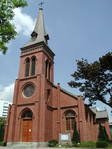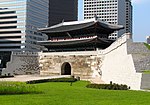Korea JoongAng Daily
2000 establishments in South KoreaCentre-right newspapersConservative media in South KoreaEnglish-language newspapers published in AsiaMass media in South Korea stubs ... and 2 more
Newspapers published in Asia stubsNewspapers published in South Korea
Korea JoongAng Daily is the English edition of the South Korean national daily newspaper JoongAng Ilbo. The newspaper was first published on October 17, 2000, originally named as JoongAng Ilbo English Edition. It mainly carries news and feature stories by staff reporters, and some stories translated from the Korean language newspaper. Korea JoongAng Daily is one of the three main English newspapers in South Korea along with The Korea Times and The Korea Herald. The newspaper is published with a daily edition of The New York Times and it is located within the main offices of the JoongAng Ilbo in Sangam-dong, Mapo-gu, Seoul.
Excerpt from the Wikipedia article Korea JoongAng Daily (License: CC BY-SA 3.0, Authors).Korea JoongAng Daily
Fortress Wall of Seoul Trail4 -Inwangsan Course, Seoul
Geographical coordinates (GPS) Address Nearby Places Show on map
Geographical coordinates (GPS)
| Latitude | Longitude |
|---|---|
| N 37.5615 ° | E 126.971 ° |
Address
삼성생명 서소문빌딩
Fortress Wall of Seoul Trail4 -Inwangsan Course
04512 Seoul
South Korea
Open on Google Maps









